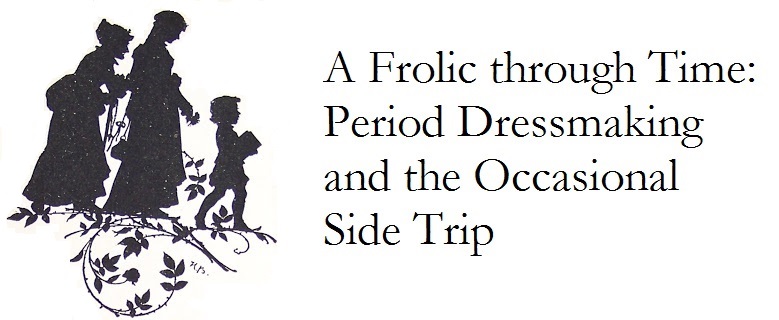 |
| Before the fitting, on with the corset. |
The bodice pattern is Truly Victorian TV 400, the 1871 Day Bodice. Heather McNaughton, Truly Victorian's creator and pattern designer, developed a novel fitting system. One takes careful measurements of one's body, and then selects individual pattern pieces that best fit the measurements. Since I am fairly proportionally sized, and also 5'5" tall, all my pattern pieces are size E. That might not be the case for someone else: they might use pattern D for one piece, and pattern E for several others, etc. In this way there is less fitting needed.
Fitting Notes
Not all fitting issues can be solved by a pattern (how many times have we heard that?), hence the need for fitting. Per Heather's admonition, we made all the fittings to the two front pieces, with the exception of making the side pieces just adjacent a little narrower.
We found that we had to reshape the darts into a fish shape, and take up a great deal of the front piece's shoulder line to smooth out the entire front and to avoid gapping when I leaned over. After all, I am a mature woman, and my chest lacks the roundness of a younger person; the allowance for roundness had to be taken up.
I am so fortunate Jenni lives nearby: she is a good fitter. It is SO nice to have help. Else I'd have been tweaking for weeks -- months, really -- as I had to for the Regency cross-front dress.
 |
| This picture is a howl! Christopher is so solemn, and I seem to be sensible that I am am wearing what appear to be shoulder wings. Fly, fly away! |
Notice the hollows above the bust, next to the underarms. Ah, the effects of aging. Elizabeth Stewart Clark of The Sewing Academy has discussed that hollow many times on her forum, and teaches us how to deal with it in her sewing guide, The Dressmaker's Guide, Second Edition. Light padding! Yep, padding, no thicker than what one might find on this decade's typical bra, but placed a little higher. By the way, I've found her book invaluable over the years, not just for mid-century sewing, but for modern sewing. Her instructions are concise, crystalline, comforting; her discussion of bodice draping is one of the best around. Want to learn to swing a dart? That book will bond how it's done into your memory.
 |
| Geek note: for better fitting, get your hair out of the way. No hair clip? Wind hair into a chignon and stick a pencil through it. Geekalicious. |
 |
| Hello, says my sweet helper! |
You can see the hollowing above the bust and near the underam very clearly here.
Again, there's a wee wrinkling in the bodice, but when it's smoothed down with the hands, it goes away, and I believe that when the bodice and skirt are hook-and-eyed together, it will be pulled into straightness.
When I lean over, there is no gapping. That's important. The bodice fits like a sort of skin, as it should.
The bodice is long. I will trim it off to a slightly higher than natural round waist, per 1870.
Post Fitting Notes
We marked all the changes carefully while I was still wearing the toile. Later I darkened the markings, and evened them out, recut the edges of the toile pieces as needed to get rid of excess, and then made a master copy in Swedish tracing paper, complete with all markings. Because the left side doesn't quite match the right side -- one of my shoulders is a slightly different shape -- there are 8 pattern pieces for the bodice (excluding sleeves), not just four.
I am reusing the final toile as the lining. Here it is.
The seamlines are marked as solid lines. If the vertical seamlines connecting the pieces together appear to have a lot bigger seam allowance than Heather's 1/2", well, they do. That's because I am constructing the bodice according to directions from Harper's Bazar, circa 1868. The directions have you use lapped seams, which I am used to from Regency-era sewing, and into which bones are inserted. No need to create boning channels! Integral seam finishing! What's not to like?
I will be following these same directions for the rest of the bodice: for the piped armscyes and the cording at neckline and waistline, for the front closure, and so on. The directions are straightforward. The highly detailed article, which covers putting together bodices and skirts, is a gem, and is superbly illustrated with the original copperplate drawings from the magazine. It delves into minute detail: exactly how to construct plackets, fabrics to be used for linings, making and attaching shank buttons, stitches to use, cording and piping, seam allowances...
You can find the article in Frances Grimble's Reconstruction Era Fashions, a fantastic book I've had on my shelf for several years. Patterns for everything you need for 1868-69, and with a little tweaking, through maybe 1871.
Today I leave you with...
...the twins, driving Chitty Chitty Bang Bang, the marvelous Edwardian roadster that could float and fly. We're in the middle of it (we watch little bits at a time), and we're having such fun!


.jpg)

2 comments:
Dear Natalie,
what fun to a have a proper fitting with friends to aid. This is so helpful for the process/progress!
I had to laugh out loud about your lovely little helper in the pictures! That must surely be one of the amazing days with lots of laughter all around, needles flying and happy chatting!
I'm looking forward to learning more about this "steampunk".
Sabine
Hi Natalie, it's looking great and you are being hypercritical, girl! Or should I say woman! :) I know exactly what you mean about being 40 mumble in the bust dept. They refuse to fight back. Hrmph. ;-)
Post a Comment